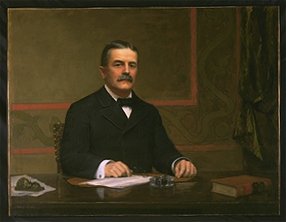Charles S. Fairchild (1842 - 1924) became Assistant Secretary of the Treasury under Daniel Manning in 1885. When Manning's health forced him to retire in 1887 President Cleveland promoted Fairchild to Secretary of the Treasury. Upon assuming the Office of the Secretary, Fairchild was confronted with a huge government surplus, the result of heavy taxation and large Customs receipts. In order to prevent more money from accumulating in the Treasury vaults, Fairchild appealed to Congress to reduce taxation and to allow Treasury to deposit Treasury funds in commercial banks, an action then not permitted by law.

Sec. Charles S. Fairchild
Robert C. Hinckley
Oil on canvas
1889
59 1/2 x 70 x 4 3/4"
P.1889.1
Congress refused to act and Fairchild took matters into his own hands. By buying back government bonds from commercial banks which held them as investments, and increasing government deposits in commercial banks over the next two years, he was partly able to dispose of the surplus revenue. Fairchild suffered sharp congressional criticism, but he continued with his policy of putting funds into circulation and averted a financial crisis. He resigned at the end of Cleveland's term in 1889.
About the Artist
Massachusetts born, Robert C. Hinckley (1853 - 1941) spent seventeen years in Paris studying with Carolus-Duran and at the Ecole des Beaux-Arts. Upon his return to the United States, Hinckley made Washington, D.C. his home. He was a fashionable portrait painter, fulfilling commissions for the Federal Government as well as private patrons. Hinckley also had a penchant for large group portraits, such as his history painting The First Ether Operation, now hanging in the Boston Medical Library. His portrait of Charles S. Fairchild, painted from life in 1889, is most likely set in the Secretary's Office at the Treasury Building.
